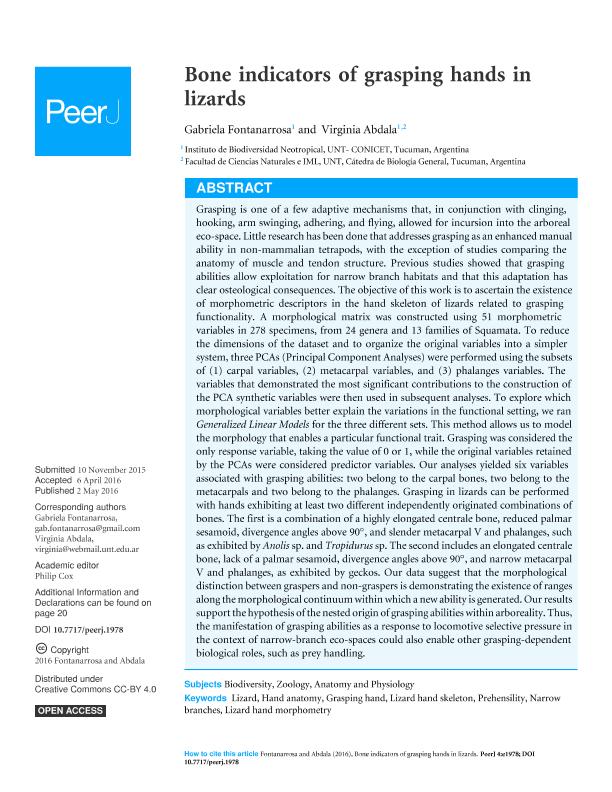Artículo
Bone indicators of grasping hands in lizards
Fecha de publicación:
05/2016
Editorial:
PeerJ
Revista:
PeerJ
ISSN:
2376-5992
Idioma:
Inglés
Tipo de recurso:
Artículo publicado
Clasificación temática:
Resumen
Grasping is one of a few adaptive mechanisms that, in conjunction with clinging, hooking, arm swinging, adhering, and flying, allowed for incursion into the arboreal eco-space. Little research has been done that addresses grasping as an enhanced manual ability in non-mammalian tetrapods, with the exception of studies comparing the anatomy of muscle and tendon structure. Previous studies showed that grasping abilities allow exploitation for narrow branch habitats and that this adaptation has clear osteological consequences. The objective of this work is to ascertain the existence of morphometric descriptors in the hand skeleton of lizards related to grasping functionality. A morphological matrix was constructed using 51 morphometric variables in 278 specimens, from 24 genera and 13 families of Squamata. To reduce the dimensions of the dataset and to organize the original variables into a simpler system, three PCAs (Principal Component Analyses) were performed using the subsets of (1) carpal variables, (2) metacarpal variables, and (3) phalanges variables. The variables that demonstrated the most significant contributions to the construction of the PCA synthetic variables were then used in subsequent analyses. To explore which morphological variables better explain the variations in the functional setting, we ran Generalized Linear Models for the three different sets. This method allows us to model the morphology that enables a particular functional trait. Grasping was considered the only response variable, taking the value of 0 or 1, while the original variables retained by the PCAs were considered predictor variables. Our analyses yielded six variables associated with grasping abilities: two belong to the carpal bones, two belong to the metacarpals and two belong to the phalanges. Grasping in lizards can be performed with hands exhibiting at least two different independently originated combinations of bones. The first is a combination of a highly elongated centrale bone, reduced palmar sesamoid, divergence angles above 90°, and slender metacarpal V and phalanges, such as exhibited by Anolis sp. and Tropidurus sp. The second includes an elongated centrale bone, lack of a palmar sesamoid, divergence angles above 90°, and narrow metacarpal V and phalanges, as exhibited by geckos. Our data suggest that the morphological distinction between graspers and non-graspers is demonstrating the existence of ranges along the morphological continuum within which a new ability is generated. Our results support the hypothesis of the nested origin of grasping abilities within arboreality. Thus, the manifestation of grasping abilities as a response to locomotive selective pressure in the context of narrow-branch eco-spaces could also enable other grasping-dependent biological roles, such as prey handling.
Palabras clave:
Grasping
,
Hands
,
Lizards
,
Glms
Archivos asociados
Licencia
Identificadores
Colecciones
Articulos(IBN)
Articulos de INSTITUTO DE BIODIVERSIDAD NEOTROPICAL
Articulos de INSTITUTO DE BIODIVERSIDAD NEOTROPICAL
Citación
Fontanarrosa, Gabriela; Abdala, Virginia Sara Luz; Bone indicators of grasping hands in lizards; PeerJ; PeerJ; 1978; 5-2016; 1-28
Compartir
Altmétricas




